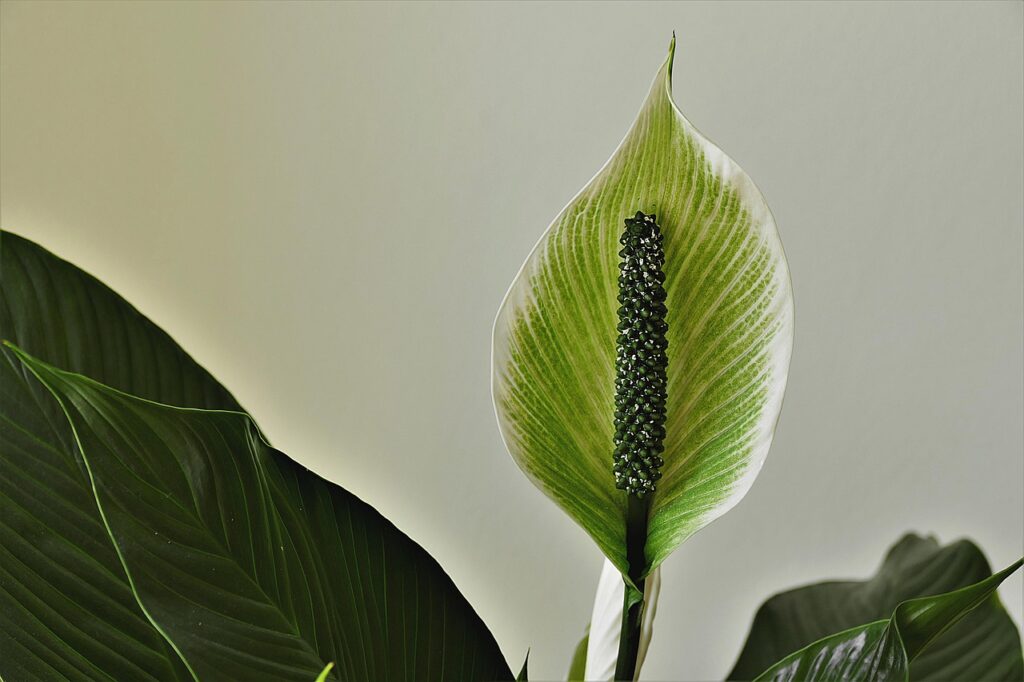What’s not to love about peace lily, an easy-to-grow indoor plant that brings life and color to low-light spots while also purifying the air. Follow our advice for growing and maintaining peace lily and it’ll soon become your go-to gift plant for friends and family, too.
Peace lilies are tropical species and hybrid from the Spathiphyllum genus that are favorite flowering houseplants. A striking plant when used in mass display, the peace lily blooms in spring with long-lasting flower stalks that hover gracefully over the foliage. The plant has glossy oval leaves with points that emerge from the soil. A well-grown peace lily may bloom twice a year, resulting in several months of flowers.
Peace lilies are indisputably terrific as houseplants. Small varieties look attractive on a tabletop and bigger ones can occupy a nice-sized spot on the floor. They filter more indoor pollutants than most other plants, so are great for bedrooms or other frequented rooms. Inside the tropical plant’s pores, toxic gases like carbon monoxide and formaldehyde are broken down and neutralized. Peace lily can also be grown outdoors in warm climates, where it can tower as much as 6 feet high.
When grown in the garden in the tropical and subtropical climates where they are hardy, peace lilies are normally planted as container-grown nursery plants in the spring while it is still cool. As houseplants, they can be purchased and brought into the home at any time, though you will want to protect the plants from cold temperatures as you move them from the store to your home.
How to Grow Peace Lily

Light
Peace lilies are a good choice for low-light spaces because they can thrive in shade or partial shade. They also tolerate fluorescent lights, so if you need a plant friend to liven up your desk at the office, peace lily is a good option.
Temperature
Fertilizing
Watering
Peace lilies like to be watered a lot at once, but also need a chance to dry out afterward. The plant will droop a bit when thirsty, telling you when it needs a drink. If you pay attention to when it usually starts to sag, you can plan to water one day before it generally happens. Watering about once a week and spritzing leaves with water throughout the summer will help keep your peace lily hydrated. If your plant seems to completely droop, don’t give up — water and spritz and give it a chance to revive. If your water is chlorine-heavy, let a container of water stand overnight before watering the plant.
Propagating Peace Lily
The peace lily is generally propagated by dividing clumps during repotting activities. Inspect the plant for small offshoot crowns located adjacent to the main mother plant; this is a sign the plant is ready to propagate.
Remove the entire plant from its container, then tug apart or cut away the adjacent crowns. You can also simply cut away a section of the main root ball. Any piece that has two or more leaves and attached roots will likely grow successfully.
Immediately plant the pieces in a roomy container filled with a good quality peat-based potting mix. Water thoroughly and keep constantly moist until new leaves begin to develop.
Potting and Repotting Peace Lily
Peace lilies are best grown in large pots and generally should be kept somewhat root-bound. But when the plant has clearly exceeded the capacity of the pot, it can be potted up to a larger container in the early spring. Always use a high-quality potting soil, and a pot with good drainage.
Diseases and pests
Peace lily is prone to the following pests:
- Mealy bug: appears as small white fluffy lumps near leaf stem bases. A range of products are available for treating this pest, and multiple treatments may be needed. Ask your plant specialist for guidance.
- Scale insects: these are generally small, brown lumps on the underside of leaves and stems. They’re easily treated with a suitable horticultural or pest oil.














